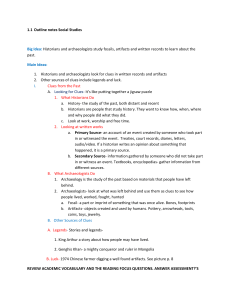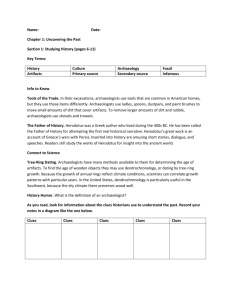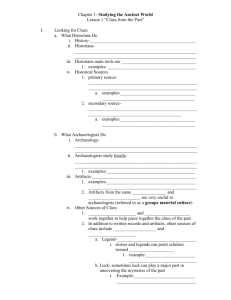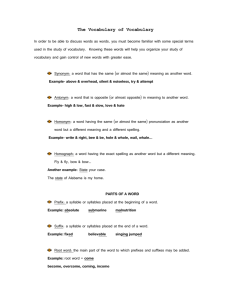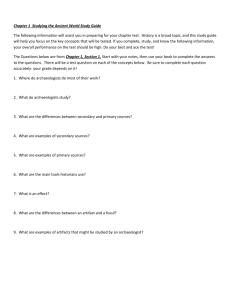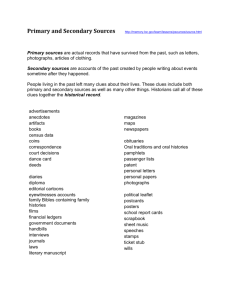Ch-1-Lesson-1-2-notes
advertisement
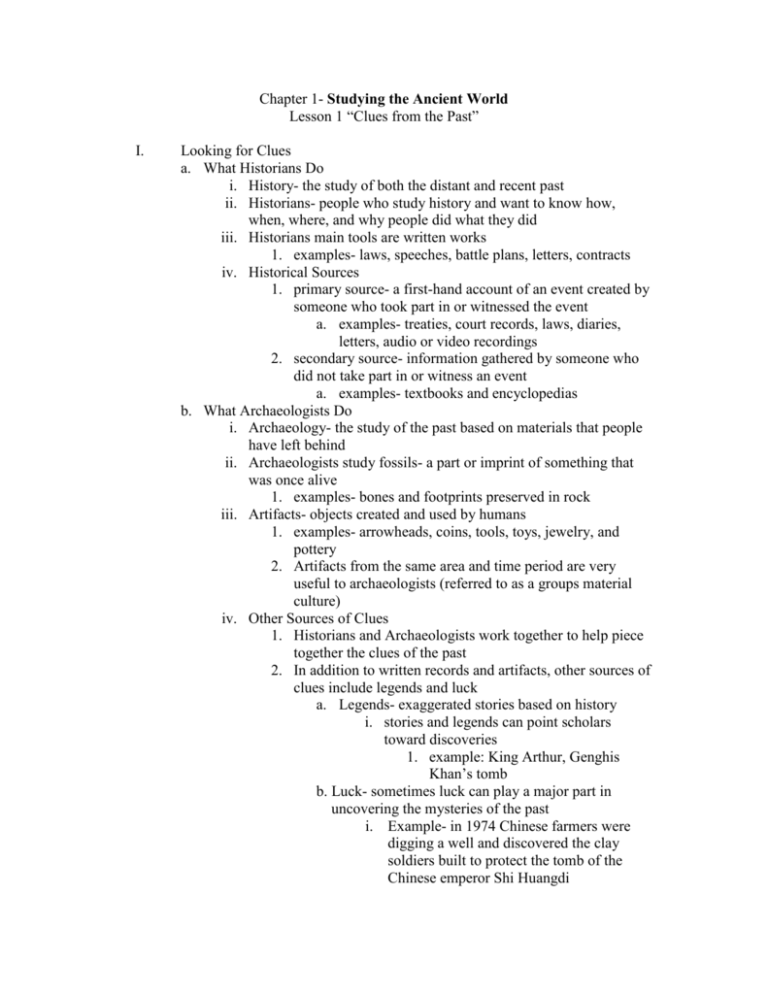
Chapter 1- Studying the Ancient World Lesson 1 “Clues from the Past” I. Looking for Clues a. What Historians Do i. History- the study of both the distant and recent past ii. Historians- people who study history and want to know how, when, where, and why people did what they did iii. Historians main tools are written works 1. examples- laws, speeches, battle plans, letters, contracts iv. Historical Sources 1. primary source- a first-hand account of an event created by someone who took part in or witnessed the event a. examples- treaties, court records, laws, diaries, letters, audio or video recordings 2. secondary source- information gathered by someone who did not take part in or witness an event a. examples- textbooks and encyclopedias b. What Archaeologists Do i. Archaeology- the study of the past based on materials that people have left behind ii. Archaeologists study fossils- a part or imprint of something that was once alive 1. examples- bones and footprints preserved in rock iii. Artifacts- objects created and used by humans 1. examples- arrowheads, coins, tools, toys, jewelry, and pottery 2. Artifacts from the same area and time period are very useful to archaeologists (referred to as a groups material culture) iv. Other Sources of Clues 1. Historians and Archaeologists work together to help piece together the clues of the past 2. In addition to written records and artifacts, other sources of clues include legends and luck a. Legends- exaggerated stories based on history i. stories and legends can point scholars toward discoveries 1. example: King Arthur, Genghis Khan’s tomb b. Luck- sometimes luck can play a major part in uncovering the mysteries of the past i. Example- in 1974 Chinese farmers were digging a well and discovered the clay soldiers built to protect the tomb of the Chinese emperor Shi Huangdi Chapter 1- Studying the Ancient World Lesson 2 “Putting the Pieces Together” I. Using the Evidence a. Historians, archaeologists, along with other experts gather clues from the past and reveal information about past societies i. Society- a community of people who share a common culture b. Social Structures and Family Life i. Social structure- the way a society is organized ii. Various works of art and literature can tell us about the social structures and family life of different cultures c. Politics and Economic Systems i. Written sources can be useful for learning about politics or government 1. Example- many politicians speeches from ancient Athens have survived in written form ii. Some written sources can also be helpful when learning about a society’s economic situation (the value of goods and services) 1. Examples- Business records showing the value of different products as well as lists telling us how much workers were paid iii. Artifacts can also be helpful when searching for clues about a society’s economic situation 1. Example- Roman coins found in China and Chinese coins found in Rome during the same time period tell us that these two countries traded with each other 2. Sometimes the actual items that were traded are discovered a. Example- obsidian (rock used for making weapons) was found miles away from the stone’s sources. This tells archaeologists how far trade extended d. Language i. Historians have to use clues from known languages to help them understand old or unknown languages 1. Example- Rosetta Stone e. Art and Architecture i. Art 1. A society’s artwork can clue us into their religious beliefs a. Examples- handcrafted furniture, jewelry, toys, and other everyday items were found in Egyptian tombs. This shows that the Egyptians believed that the deceased would need these items in the afterlife 2. Art can also give us clues about a society’s level of technology a. Archaeologists found bronze objects with amazing detail in the area where the people of the Shang Dynasty in China lived which shows that they had incredible metalworking skills ii. Architecture 1. Clues from the number and type of buildings a. many temples= importance of religion 2. The structure of the buildings reveal clues too a. ancient castle with thick stone walls= war was a problem and they needed extra protection against enemies b. beautiful Greek temples= importance of Greek gods c. buildings with rounded arches= shows the Roman’s engineering talents f. Beliefs and Values i. Written sources 1. Teachings of Confucius= importance of family in Chinese society 2. The Code of Hammurabi= Babylonian ruler valued justice ii. Unwritten sources 1. Greek statues of athletes and images of athletes= importance Greeks placed on sports II. Views of the Past i. Views of the past change due to new discoveries and new interpretations b. New Discoveries i. Archaeologists found old bones in Africa and the Americas which may require the time lines of human development to be completely rewritten ii. Wrecks of Roman trading ships were found far off the Mediterranean coast. This suggests that sailors could navigate the open waters earlier than experts thought c. New Interpretations i. The growth of democracy, the civil rights movement, and women’s movement have affected how we study history
